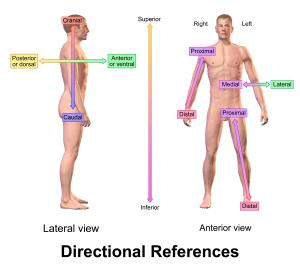
The Brookbush Institute Announces New Lessons on the Anatomical Position and Anatomical Directions
A better teaching approach is needed for introducing anatomical position and directions to fitness, sports performance, and physical rehabilitation students.
INTRODUCTION from "Lesson 1: Anatomical Position and Anatomical Directions"
(from "Introduction to Functional Anatomy Courses" at BrookbushInstitute.com)
The "New Language" of Anatomy:
Students have often remarked that taking their first anatomy courses feels like trying to learn a new language, and that is a great analogy for the first few lessons of Introduction to Functional Anatomy. The first 6 lessons, or so, are exactly that, "learning the language of anatomy." Why does it feel like a new language? Well, it actually is a new language for most of us (or a really old language), as most terms have Latin roots (some Greek). Just as you would practice using new vocabulary in a language class, you will need to do the same with new terms you learn in this course. Grab a co-worker, classmate, or colleague; make flashcards, use practice exams to quiz one another, and copy the "Anatomy Simon Says" activity from this course. The most important thing to do is practice using the terms.
Definitions:
- Anatomical Position: This is an anatomical reference position - the body in a standing position, eyes and head forward, arms at sides with palms forward, and feet together and parallel.
- Anatomical Directions: Anatomical directions are terms used to describe a location on the body. Many of the words have roots that may look familiar to you. Note, all anatomical directions are paired; that is to say, each has an opposite. The anatomical directions are paired with an opposing direction; superior (toward the head) is paired with inferior (toward the bottom), medial (toward the middle) is paired with lateral (toward the side), anterior (toward the front) is paired with posterior (toward the back), proximal (near the center) is paired with distal (further from center), cranial (toward the head) is paired with caudal (toward the tail), supine (face up) is paired with prone (facedown), dorsal (on the top) is paired with plantar (on the bottom), and sometimes dorsal (on the back) is paired with ventral (on the front).
- The standard anatomical position is a reference position for describing where a body structure is located, and anatomical directions are terms for describing the relative location of a cavity, body part, or structure. If we think of the body like a map, the anatomical position tells us which way our map should face, and anatomical directions tell us how to get to our destination. These terms are "professional jargon," but they are important for improving our ability to describe anatomy with more detail and accuracy.
For example, using this terminology, we could describe the stomach's position as follows: In anatomical position, the stomach is located proximally (toward the center of the body), within the abdominal cavity (peritoneum), inferior to the liver and superior to the transverse colon, deep or posterior to the abdominal wall and rectus abdominis muscles, and superficial or anterior to the pancreas and spine.
Knowledge of the anatomical positions and directions is essential education for all sports medicine professionals (personal trainers, fitness instructors, physical therapists, athletic trainers, massage therapists, chiropractors, occupational therapists, etc.). This course is essential for learning anatomy, and the next lesson in these Introduction to Functional Anatomy courses - Lesson 2: Planes of Motion. More advanced courses on anatomical structures, movement analysis, health and wellness, fitness, sports performance, strength and conditioning, physical rehabilitation, etc. will continue with the expectation that the student thoroughly understands these terms.
This Course Includes:
- Video Lecture
- Study Guide
- Text descriptions
- Illustrations
- "Simon Says" learning activity
- Practice Exam
- Continuing Education and Certification Approved Final Exam
Brent Brookbush
Brookbush Institute
+1 2012069665 ext.
email us here
Visit us on social media:
Facebook
Twitter
LinkedIn
Instagram
YouTube
TikTok
EIN Presswire does not exercise editorial control over third-party content provided, uploaded, published, or distributed by users of EIN Presswire. We are a distributor, not a publisher, of 3rd party content. Such content may contain the views, opinions, statements, offers, and other material of the respective users, suppliers, participants, or authors.


